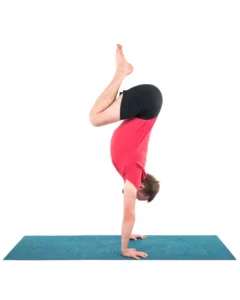Finding Your Yoga Teaching Niche: Building a Unique and Sustainable Career

Do you have a yoga teaching niche? Making yoga a viable career can be challenging, but finding your unique niche can make the endeavor more sustainable and rewarding. This article explores how to identify your specialty, create distinctive class characteristics, and help students appreciate the unique value of your offerings.
Why You Need a Yoga Teaching Niche
When I began teaching yoga in 2017, I wanted to teach to everyone. I loved teaching all-level Vinyasa classes, but I started to feel frustrated about two years into teaching only this. Teaching yoga was starting to feel like a popularity contest that was impossible to win. Some of my regulars wanted more Restorative poses, while others only wanted to practice Handstand (Adho Mukha Vrksasana). Some liked an active, challenging class, while others just wanted to relax. Some wanted to flow to a jazzy playlist, while others preferred to practice in silence. While I was wading in the deep waters of conflicting requests, a realization hit me like a tidal wave: I couldn’t be the perfect teacher for everyone.
Conveniently, this realization came around the same time as my first pregnancy. Out of personal interest, I signed up for an 85-hour prenatal yoga teacher training and learned I loved the topic more than I would have ever guessed. With my background in maternal health research, prenatal yoga became the teaching style I felt most called to teach. And it was so rewarding!
This is how I found my niche, but my story is not unique. I’ve heard similar struggles from many other new yoga teachers and success stories from other yoga teachers who have found a niche and made their careers financially viable and fulfilling. In today’s highly competitive yoga market, it’s nearly impossible to exist as a jack-of-all-trades. A well-defined teaching specialty can set you apart from other yoga teachers and allow you to be of greater service to your students.
How to Find Your Yoga Teaching Niche

Ready to find your teaching niche? The first step is to a process of deep reflection. Think about your interests and strengths as a yoga teacher and in daily life. Here are some questions to guide you:
- Your Yoga Journey: Why did you start practicing yoga? Which type of yoga drew you to the mat? What did you learn from your early days of practicing yoga? How has your practice evolved over the years?
- Your Interests and Passions: What type of yoga do you enjoy practicing the most? What about it do you love? What styles are you most excited to learn more about?
- Strengths and Skills: What strengths and skills do you have to offer as a yoga teacher? What strengths and skills do you have apart from yoga? How could these strengths and skills contribute to your value as a teacher?
Reflecting on these questions will help you identify the areas where you are most passionate and can offer the most value.
Who Do You Want to Teach? Define Your Dream Yoga Student
Next, reflect on the type of client you’d like to serve. Create a detailed profile of your ideal student, making it as detailed as possible so you can envision integrating them into your community and spending time with them even outside of class. Here are some questions for reflection:
- What are some specific characteristics of your dream student? Think about age range, gender(s), and what they do outside of yoga.
- What are your dream student’s specific needs and goals related to yoga?
- What challenges do they face that yoga can help them address?
For example, dream prenatal yoga students might look something like this: women aged 20-45 who also like public health, travel, full moon ceremonies, and vegetarian food. They may want to practice yoga to reduce stress during pregnancy, connect with their baby, and build a community of other like-minded pregnant people. They may also have fears around birth, either because this is their first time giving birth or because they had a past traumatic birth, and yoga can also offer them tools to give birth with confidence. Get creative and specific when you’re dreaming up the community you seek to create, and you may be surprised to see who walks into class when you’re teaching your niche!
Explore In-Demand Yoga Teaching Niches

I’ve used prenatal yoga as an example throughout this article because it’s what I teach, but that’s not the only yoga teaching niche out there! The list of niches is limitless, but when you think about crafting your niche, you’ll also want to think about your community and what their needs are. Whether you teach in-person or online, you may want to think about niches that are currently in demand, such as children’s yoga, yoga for seniors, yoga for mental health, or eco-yoga that focuses on connecting with and protecting the land.
If any of these in-demand niches resonate with you, get more specific! For example, if you’re a therapist, you could offer yoga for mental health classes followed by group therapy sessions for women going through divorce. Or, if you’re an artist and educator, you could offer yoga in school settings for elementary children paired with nature-based art. The more specific you get, the easier it will be to market your classes and attract your ideal students.
Next Steps in Building a Career as a Yoga Teacher
Once you’ve selected a yoga teaching niche, think of what you already have to offer and what you’ll need to make yourself stand out. What level of experience and qualifications do you currently have, and what additional certifications or trainings might you need? What additional props or materials might you need to offer your teaching niche to your community? If you’ll be teaching online, do you have all the equipment needed to film, edit, and upload yoga videos? It’s important to ground your passion in reality by considering these important questions.
Once you’re ready to bring your offering to the world, be ready to communicate the unique benefits of your class structure to your students. Explain how your approach helps them achieve their goals, whether it’s through your expertise in playlisting, your knowledge of anatomy, or your poetic use of metaphors in meditation. This helps students understand and appreciate the value of your specific teaching style and helps your dream student to find you more easily.
Creating Special Class Characteristics: Don’t Be Afraid to Stand Out!

Once you start teaching with your new niche in mind, it’s important to remember that not everyone is going to like your classes. And that’s okay! By being authentic to your skills, strengths, and passions, you’re far more likely to attract a loyal group of students who love your classes than by being a teacher who’s likable but not memorable. These loyal students will be the ones who benefit most from what you have to offer, which can make your work as a yoga teacher all the more rewarding.
To retain these students, it’s crucial to connect with them during class. This could be through checking in at the beginning of each session or offering tailored advice. It’s equally important to hear their feedback regularly, such as by asking for class requests or being open to conversation before or after class. This not only enhances the class experience but allows students to feel valued and heard.
The Secret to A Fulfilling Career as a Yoga Teacher: Embracing Your Unique Teaching Style
Carving out a niche in the competitive yoga market is crucial for success. It can take time to build a teaching niche, but with patience and persistence, your unique style can shine to attract dedicated students. Committing to your craft, you can build a successful and fulfilling yoga career.
Also, read...
Working with the Fascial Network: The Art of Self-Myofascial Release
Apr 10 – By: YogaU Staff
Simplify Your Yoga Cues to Increase Their Power
Mar 05 – Charlotte Bell
Related courses
Breath as Medicine: Yogic Breathing for Vital Aging
With Doug Keller
Yoga and Myofascial Release: Releasing Chronic Tension with the Bodymind Ballwork Method
With Ellen Saltonstall
Yoga and Detoxification: Tips for Stimulating Lymphatic Health
With Lisa Levitt Gainsley

Lacey Ramirez writes for YogaUOnline and is an RYT-500 & ERYT-200 yoga teacher, global health researcher, and writer based in St. Louis. Through her work, she seeks to make yoga accessible, inclusive, and equitable.
Lacey discovered yoga as a tool for centering during her years as a competitive runner. Since then, yoga has served as a way to connect with her body throughout her experience of pregnancy and parenthood. She teaches because she hopes others can use this sacred practice for calming, healing, and transformation.
As a yoga teacher, Lacey specializes in teaching restorative, Yin, prenatal, and trauma-informed Vinyasa yoga. She has also completed birth doula and prenatal/postnatal barre certifications and trainings. Additionally, she holds a Masters of Science in Global Health and Population from Harvard T.H. Chan School of Public Health. To learn more and connect, visit her website laceyramirez.com
Recent articles
Fascia and the Vagus Nerve: Healing from the Inside Out
Jul 10 – Dr. Arielle Schwartz
Change Your Perspective of Pelvic Tilting: How the Transversus Abdominis Can Help
Jul 08 – Olga Kabel C-IAYT
Warrior I Pose: 5 Strengthening Variations
Jul 02 – Bridget Frederick, eRYT 500
Categories
Upcoming courses
Breath as Medicine: Yogic Breathing for Vital Aging
With Doug Keller
Yoga and Myofascial Release: Releasing Chronic Tension with the Bodymind Ballwork Method
With Ellen Saltonstall
JOIN NOW!
Recent articles
Almost there...
Sorry, we couldn't find anything...
Stress Relief
Fascia and the Vagus Nerve: Healing from the Inside Out
Have you ever had a morning in which you woke up with a painful…
Jul 10 – Dr. Arielle Schwartz
Pose Library
Change Your Perspective of Pelvic Tilting: How the Transversus Abdominis Can Help
“Tuck your tailbone under” or “lengthen your tailbone” have long been among the most…
Jul 08 – Olga Kabel C-IAYT
Yoga Practice Tips
Warrior I Pose: 5 Strengthening Variations
Warrior I Pose (Virabhadrasana I) is an excellent pose for strengthening your whole back…
Jul 02 – Bridget Frederick, eRYT 500



